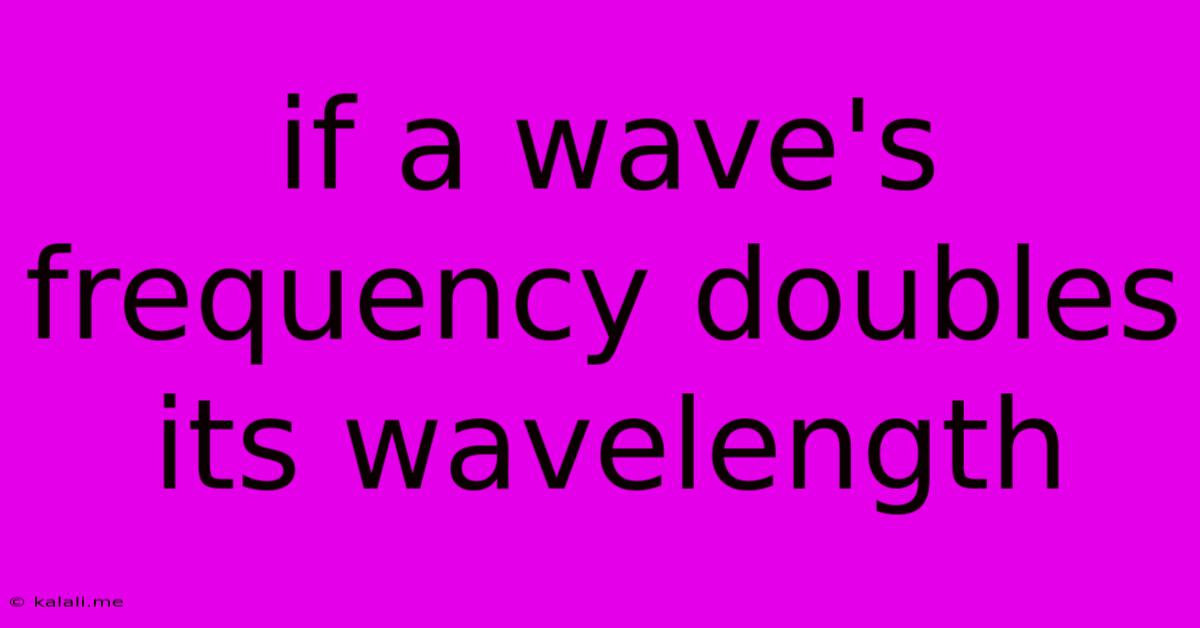If A Wave's Frequency Doubles Its Wavelength
Kalali
Jun 14, 2025 · 3 min read

Table of Contents
If a Wave's Frequency Doubles, What Happens to its Wavelength? The Inverse Relationship Explained
The relationship between a wave's frequency and its wavelength is fundamental in physics, governing everything from sound waves to light waves. Understanding this relationship is crucial for comprehending various phenomena, from the colors we see to the sounds we hear. This article will explore what happens to a wave's wavelength when its frequency doubles, explaining the underlying principles and providing illustrative examples.
Understanding the Basics: Frequency and Wavelength
Before diving into the effects of doubling frequency, let's define the key terms:
-
Frequency (f): This refers to the number of complete wave cycles that pass a given point per unit of time, typically measured in Hertz (Hz), or cycles per second. A higher frequency means more waves pass a point in a given time.
-
Wavelength (λ): This is the distance between two consecutive corresponding points on a wave, such as the distance between two successive crests or troughs. It's usually measured in meters (m).
-
Wave Speed (v): This represents how fast the wave is traveling through a medium. It's measured in meters per second (m/s).
The Fundamental Equation: Connecting Frequency, Wavelength, and Speed
The relationship between these three properties is described by a simple yet powerful equation:
v = fλ
This equation states that the wave speed (v) is equal to the product of its frequency (f) and wavelength (λ). This equation holds true for all types of waves, including electromagnetic waves (light) and mechanical waves (sound).
Doubling the Frequency: The Impact on Wavelength
Now, let's consider the scenario where the frequency of a wave doubles (f becomes 2f). Assuming the wave speed (v) remains constant – which is often the case for a given medium – we can analyze the effect on the wavelength using the equation:
- Original state:
v = fλ - Doubled frequency:
v = (2f)λ'
Notice that we've used λ' to represent the new wavelength. Since the wave speed (v) remains constant, we can equate the two equations:
fλ = (2f)λ'
Solving for λ', we get:
λ' = λ/2
Therefore, if a wave's frequency doubles, its wavelength is halved. This inverse relationship is a direct consequence of the fundamental wave equation. If you increase the number of waves passing a point per second (higher frequency), the distance between each wave (wavelength) must decrease to maintain the same speed.
Examples in Different Wave Types:
-
Sound Waves: If a sound source produces a sound with double the frequency, the resulting sound will have half the wavelength. This change in wavelength won't necessarily be directly perceptible, but it contributes to the perceived pitch. A higher frequency generally means a higher pitch.
-
Light Waves: In the electromagnetic spectrum, doubling the frequency of light shifts it towards the higher-energy end of the spectrum. For instance, doubling the frequency of red light might move it into the orange or yellow range. This is because the color we perceive is directly related to the frequency (and hence, wavelength) of the light.
Conclusion:
The relationship between frequency and wavelength is inversely proportional. When the frequency of a wave doubles while the speed remains constant, the wavelength is halved. This fundamental principle applies to all types of waves and is crucial for understanding wave behavior across various scientific disciplines. Understanding this inverse relationship allows for accurate prediction of wave properties and contributes to a deeper understanding of phenomena involving wave propagation.
Latest Posts
Latest Posts
-
What Is Difference Between Square And Rhombus
Jun 15, 2025
-
What Is The Lcm Of 16 And 36
Jun 15, 2025
-
For The Optical Fiber Shown In The Figure
Jun 15, 2025
-
What Organisms Can Make Their Own Food
Jun 15, 2025
-
Electric Field Inside A Non Conducting Sphere
Jun 15, 2025
Related Post
Thank you for visiting our website which covers about If A Wave's Frequency Doubles Its Wavelength . We hope the information provided has been useful to you. Feel free to contact us if you have any questions or need further assistance. See you next time and don't miss to bookmark.